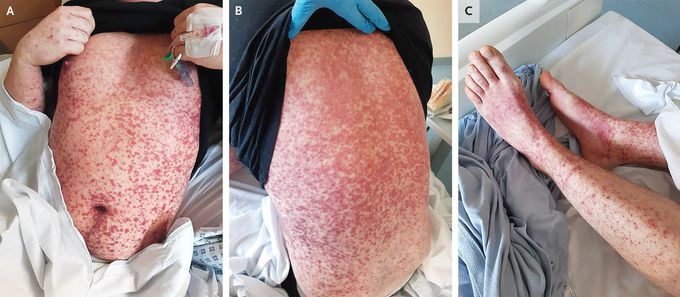


Serum Sickness
A 30-year-old man with recently diagnosed aplastic anemia presented to the emergency department with a 2-day history of fever, nonpruritic rash, and ankle and knee pain. He reported having no hives or jaw pain. Ten days before the onset of symptoms, he had completed a course of horse antithymocyte globulin as treatment for his aplastic anemia. His body temperature was 39.6°C. Physical examination was notable for a morbilliform rash across his torso (Panels A and B) and arms and a purpuric rash on the legs (Panel C). Mild swelling was noted in the periorbital region, but the mucous membranes were not involved. Laboratory studies were notable for worsening neutropenia, low C3 and C4 levels, a C-reactive protein level of 114 mg per liter (reference value, <5), and negative blood cultures. A clinical diagnosis of serum sickness was made. Serum sickness is a type III hypersensitivity reaction due to the formation of antigen–antibody or immune complexes. The condition classically occurs after the therapeutic administration of nonhuman protein and manifests as a triad of fever, rash, and arthralgia, as in this case. After a 5-day course of intravenous glucocorticoids, the patient’s symptoms had resolved. Horse antithymocyte globulin was added to the patient’s list of drug allergies and not used again.
3days post completion of ATG, 4 day history of fever, admitted to hospital after collapsing due to hypotension, no complaints of pain other than injury sustained from falling during collapse, and 10 days of glucocorticoids I/V followed by further 8days oral steroid treatment

